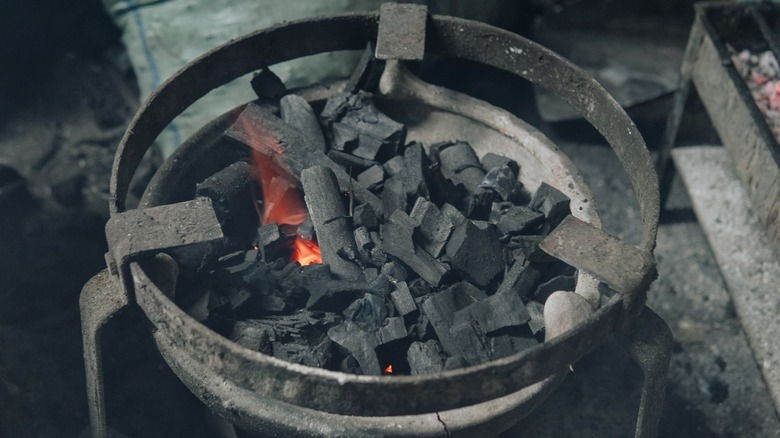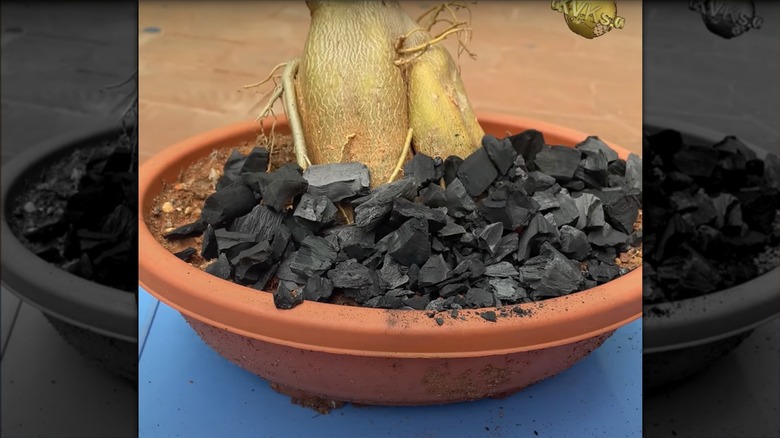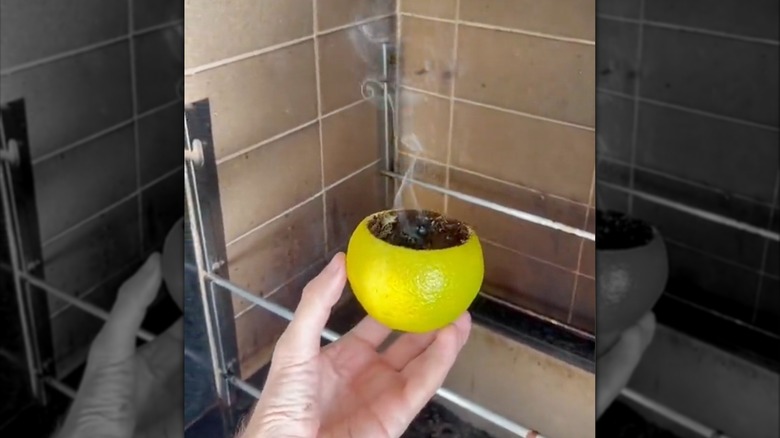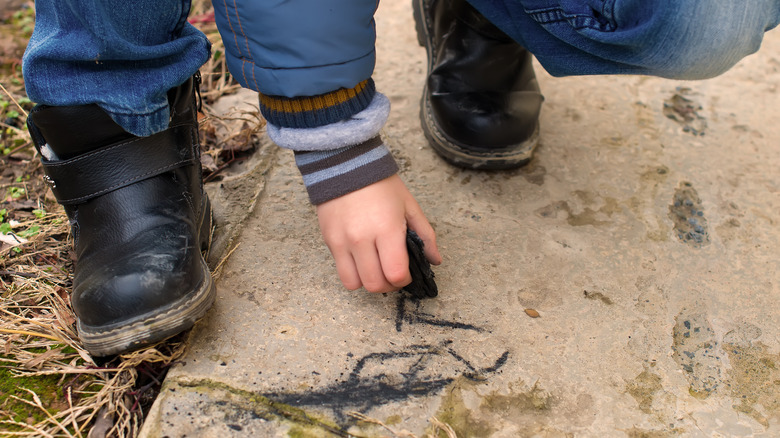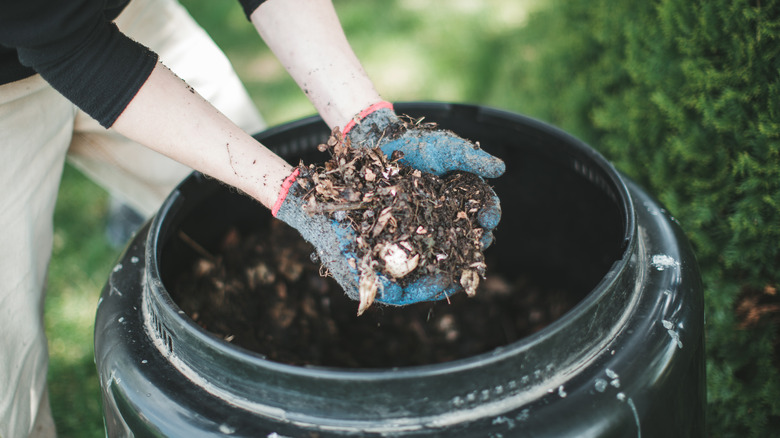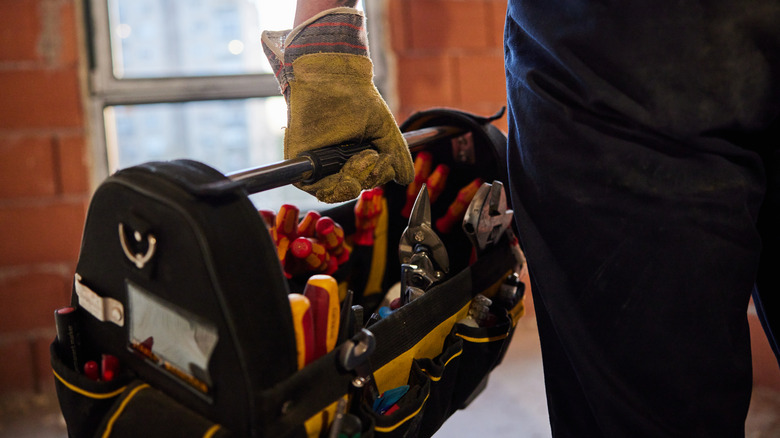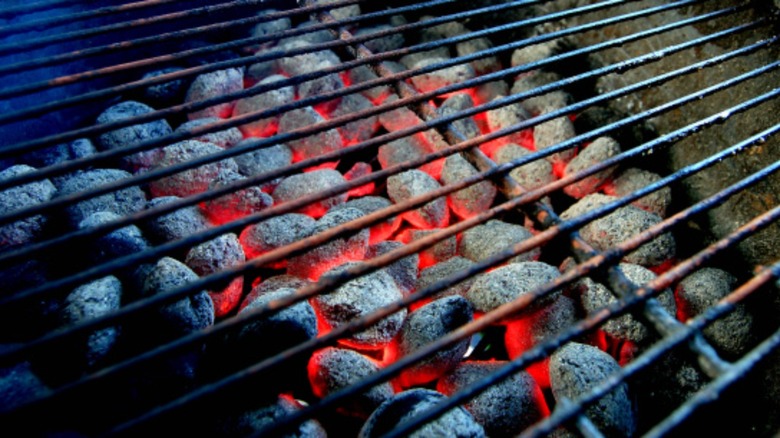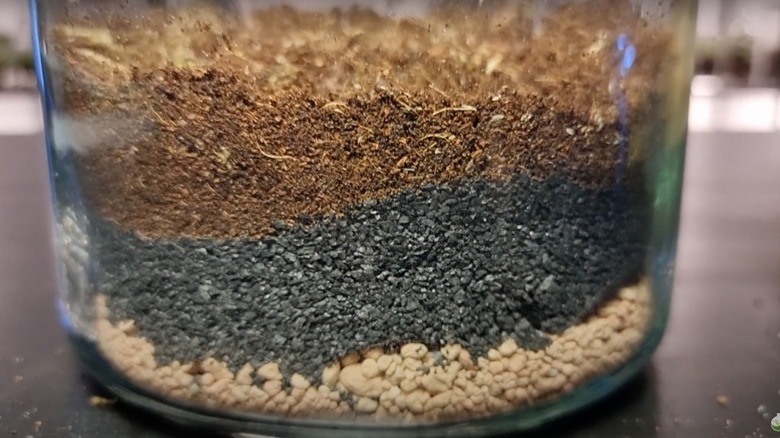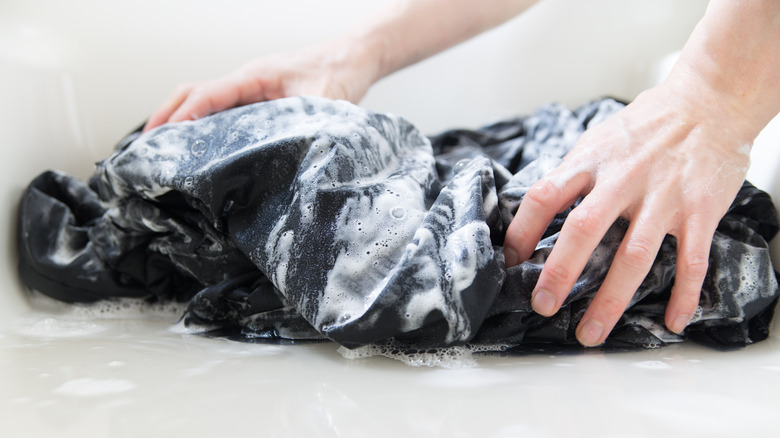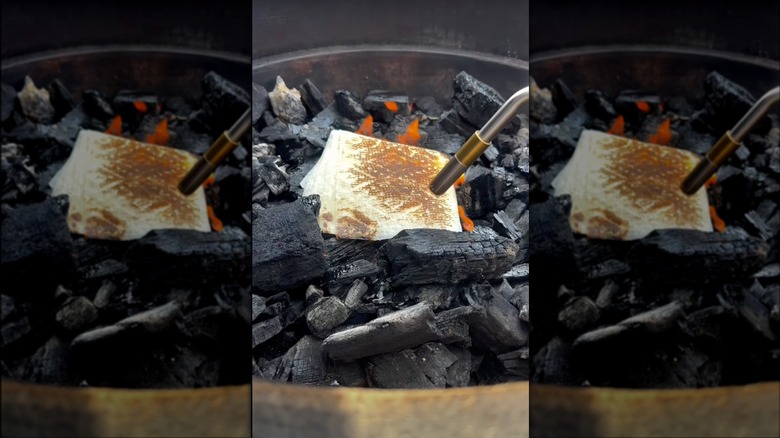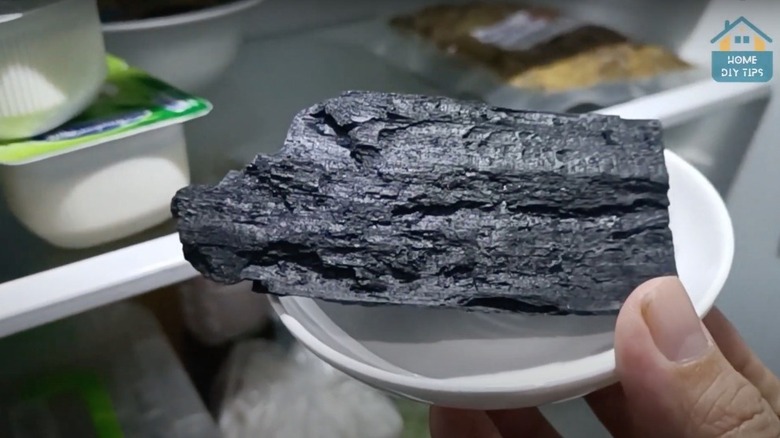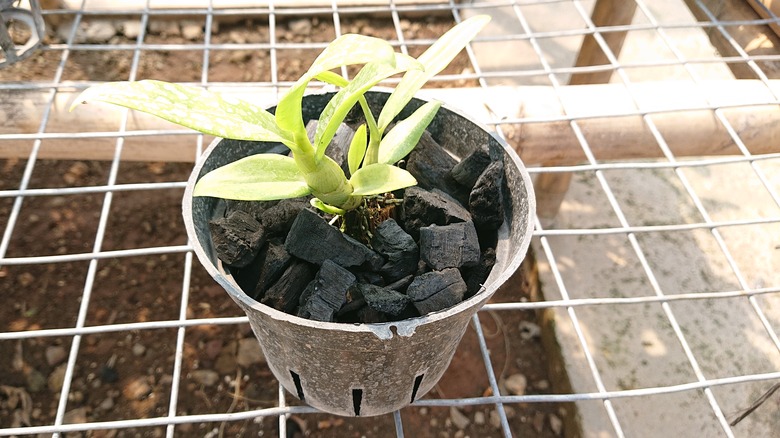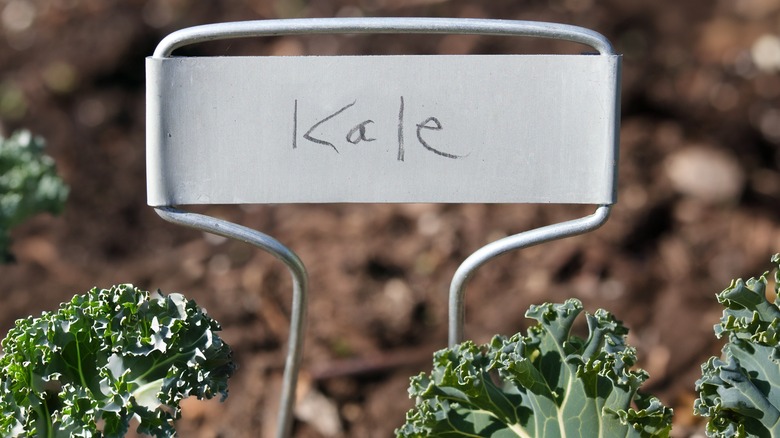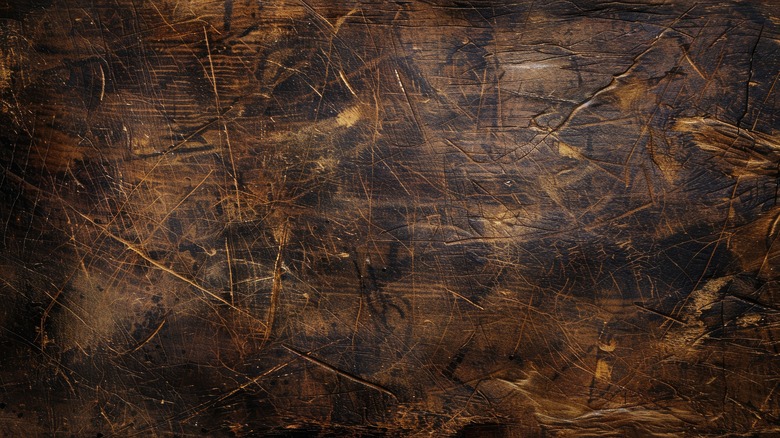15 Ways To Repurpose Charcoal Around Your Home And Garden
When you think of charcoal, what comes to mind? The smell of the BBQ on hot summer days or a cozy evening by the fire pit? It's a material nearly every home seems to have on hand during the warmer months and in leftover bags stored away during winter. Charcoal is synonymous with grilling, but its usefulness doesn't stop there. You can repurpose this material to use in new ways around your house or garden, including as a way to repel pests, enhance a compost pile, or as a way to reduce odors from surfaces or areas like the refrigerator.
However, before diving into your next DIY project, it's important to understand the differences between the types of charcoal available. Briquettes and lump varieties are used for outdoor cooking and differ from activated charcoal, a powder commonly used in the medical field to treat different conditions. If you plan to use leftover briquettes for any repurposing project, be sure it's an all-natural variety containing no toxic chemicals. Now, here are 15 ways you can use up that leftover bag instead of throwing it away.
Mulch addition or replacement
If you're looking for a cost-effective way to make sure your garden is healthy, consider using leftover charcoal as a mulch replacement. Charcoal is a material rich in carbon, an element that's crucial for healthy soil. Additionally, leftover ashes can contain minerals that your soil may be lacking, like potassium or sulfur. All you have to do is break down any leftover material and spread it throughout the mulch. It's important to note that some commercially produced charcoal briquettes may have additives, so be sure to read all labels before adding them to your garden.
Pest repellant
Don't let the pesky summer bugs ruin your time outdoors if you've got leftover charcoal! There are several ways you can keep your yard pest-free. To stop ants from bombarding your grilling area, break up your charcoal into a powder and form a line around the grill. This method will disrupt their scent trail and send them in a different direction. You can also try a hack that claims to repel bugs by placing a burning piece of charcoal into a hollow orange peel with coffee grounds. Insects do not like smoke, helping keep your space bug-free!
Snow day fun
You might not be able to grill during the chilly winter months, but there is a way to use up any rogue charcoal lumps leftover from summer grilling. Once the first snowfall of winter hits, grab the bag and head outside to make a snowman. Build the body with three separate sections of snow before decorating with embellishments like a hat, scarf, and chunks of charcoal for the face and buttons. There are no rules when it comes to this hack, so be as creative and outside-the-box as possible. Be sure to supervise children with this messy material.
Outdoor fun
Another way to repurpose charcoal that's eco-friendly and creative is using an old briquette as chalk! Charcoal is an incredibly popular drawing material that's been popular for creating art since the Renaissance period due to its ability to create depth within a piece. You can use it to create fun outdoor games like tic tac toe or four square on a nice day or use the dark color to enhance a piece of sidewalk chalk art. It will provide a rich gray-black color that is easy to work with and can be smudged for dramatic effect.
Control excess humidity
Struggling with damp areas in your home, like the basement or bathroom? Charcoal can act as a natural dehumidifier due to its absorbent nature. All you have to do is place a few pieces in a small bowl and set it in a dampness-prone area to let it work its magic. Over time, the charcoal will draw in moisture, helping to reduce humidity levels in your space. It's a low-cost and low-maintenance way to keep your home dry and comfortable before trying electric dehumidifiers.
Supercharge your compost
If you're looking to boost your compost pile, consider adding some leftover charcoal after your next BBQ. As long as you're using an additive-free variety, the leftover material can work as a carbon-rich superfood. The result? A nutrient-dense compost with an ideal texture that's ready to nourish your garden. Charcoal also helps to balance pH levels, making it especially useful if your compost is too acidic. This repurposing hack is suitable for both beginners and experienced gardeners and can take your composting efforts to the next level.
Rust prevention
Tools are an important investment, and rust prevention is key to longevity with these types of items. Rust forms when metal items have a chemical reaction with oxygen, iron, and water, resulting in corrosion on the surface of your tools. If you want to take your preventative measures to another level, adding a charcoal briquette to your toolbox, tackle box, or wherever you store metal tools will keep them rust-free. You should also try to keep any important metal items stored safely in a dry area to avoid excess humidity, which can lead to corrosion.
Simplify grill cleaning
After a weekend barbecue, the last thing you want to do is spend hours scrubbing at your grill to clean it. But, don't dump that charcoal just yet. Ignite it and heat it to help clean your grill. The process is called clean burning and is utilized by many as a way to help make cleaning stuck-on food easier. Heat up charcoal in your grill to over 400 degrees Fahrenheit, and allow the extreme temperature to break down any buildup. After a few minutes, use a brush to scrape the grates clean.
Build a terrarium
Do you love greenery but live in a location with cold and snowy winters? DIY a terrarium to enjoy the beauty of a luscious green garden all year long. Terrariums are essentially tiny ecosystems with plants that are able to self-sustain, though some variations allow for the container to be opened for care and maintenance. Most terrariums contain some type of soil, which is an element that benefits from the chemical makeup of charcoal. However, be sure to use only additive-free lump wood charcoal for this type of repurposing project to make sure the new environment thrives.
Natural dye method
If you're feeling creative, why not try using charcoal as a natural dye? Charcoal has been utilized as a method to dye fabrics throughout history, and when it's crushed (like in thisTikTok video by @livetolearnlearntolive), it produces a deep, rich black color that's perfect for fabrics like cotton. In fact, dyeing cotton with charcoal can help with bacteria levels and bring the fabric back to life. The process is similar to tye-dying and involves mixing the powder with water until boiling and then soaking the fabrics in the mixture overnight. Soak in soapy water and rinse thoroughly, and you'll get a brand-new item with subtle gray coloring.
All-natural firestarter
If you're craving s'mores and a cozy night by the fireplace just to realize there's no firestarter, don't cancel your plans. Head out to your grill and grab some charcoal briquettes and a few other ingredients to make a DIY emergency firestarter. This is also a great repurposing hack for those who are looking for an all-natural solution versus chemical firestarters. It only requires soaking your charcoal in olive oil before topping it with paper towels also soaked in the oil. Light the paper towels, and you're ready to roast marshmallows!
Odor eliminator
Are you tired of commercial air fresheners that just temporarily mask odors? Leftover charcoal offers a natural alternative that actually absorbs and neutralizes smells instead of just covering them up with additional fragrances. This simple repurposing DIY just requires you to place a few pieces of charcoal in a breathable bag or container and set it in areas where odors linger. This can be anywhere from the bathroom or kitchen to a shed or musty basement. Another great way to kill odors is by placing charcoal in the refrigerator!
Add to fresh-cut flowers
It seems like fresh-cut flowers never last long enough, wilting just a few days after setting them up in a vase. One clever hack to help flowers last longer is to add your charcoal remnants to the bottom of the container before adding the flowers and lukewarm water. You can also add lemon juice and bleach for extra power. Similar to charcoal filters, the material will help to reduce mold from forming and help flowers thrive for longer. You can also add charcoal to dying orchids as a way to help bring them back to life.
DIY plant tags
While it's common for garden tags to use permanent markers for labeling plants, consider making an eco-friendly choice and using charcoal instead. This material has been used throughout history as a tool for writing and creating drawings, and this repurposing hack is no different. If you're using charcoal in your garden, you might already have a piece handy. Instead of reaching for a marker to label your tomatoes, squash, and kale, use a chunk of charcoal to make a biodegradable mark on your garden.
Patch wood imperfections
Wood furniture is timeless but is susceptible to scratches and damage. There are hacks that can help fix scratches on wood furniture, and charcoal powder is among the best temporary solutions. However, the color of charcoal makes this repurposing DIY best for dark wood variations or areas that are not visible. It may start to rub off or fade over time, so it's best to use this method as a way to fix imperfections while waiting for a permanent solution. You could also keep adding charcoal to the affected area when you notice it wearing away.
